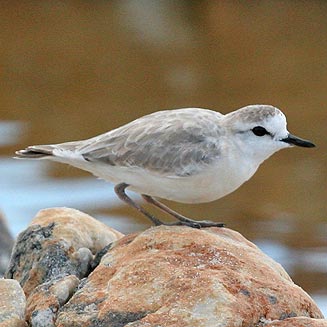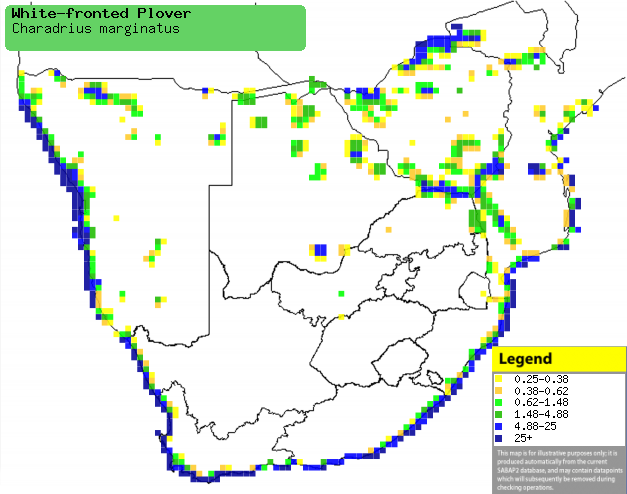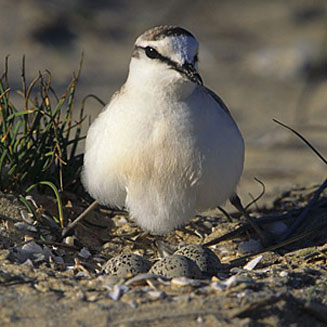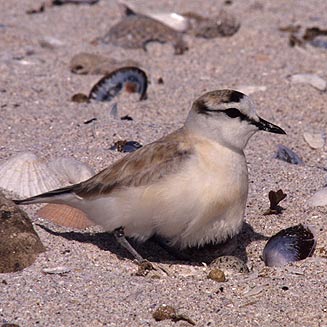|
Charadrius marginatus
(White-fronted plover)
Vaalstrandkiewiet [Afrikaans]; Unocegceya, Unotelela
[Xhosa]; Vale strandplevier [Dutch]; Pluvier à front blanc [French];
Weißstirn-regenpfeifer [German]; Borrelho-de-testa-branca [Portuguese]
Life
> Eukaryotes >
Opisthokonta
> Metazoa (animals) >
Bilateria >
Deuterostomia > Chordata >
Craniata > Vertebrata (vertebrates) > Gnathostomata (jawed
vertebrates) > Teleostomi (teleost fish) > Osteichthyes (bony fish) > Class:
Sarcopterygii (lobe-finned
fish) > Stegocephalia (terrestrial
vertebrates) > Tetrapoda
(four-legged vertebrates) > Reptiliomorpha > Amniota >
Reptilia (reptiles) >
Romeriida > Diapsida > Archosauromorpha > Archosauria >
Dinosauria
(dinosaurs) > Saurischia > Theropoda (bipedal predatory dinosaurs) >
Coelurosauria > Maniraptora > Aves
(birds) >
Order: Charadriiformes > Family: Charadriidae
> Genus: Charadrius
 |
|
|
White-fronted plover, Kleinmond, Western Cape,
South Africa. [photo
Duncan Robertson ©] |
|
Distribution and habitat
Endemic to sub-Saharan Africa; in southern Africa it is one of the most common
birds along the coastline, also occupying Zimbabwe, north-eastern South Africa,
patches of Mozambique, northern Botswana and Namibia (including the Caprivi
Strip). It generally prefers sandy shores, coastal shores, estuaries and the
sandy margins of rivers and lakes, while inland it favours wetlands with
extensive mudflats and saline pans.
|
 |
|
Distribution of White-fronted plover in southern Africa,
based on statistical smoothing of the records from first SA Bird Atlas
Project (©
Animal Demography unit, University of
Cape Town; smoothing by Birgit Erni and Francesca Little). Colours range
from dark blue (most common) through to yellow (least common).
See here for the latest distribution
from the SABAP2. |
Predators and parasites
- Predators of chicks and eggs
Movements and migrations
Largely sedentary along the coast, occasionally
moving from exposed to sheltered shores in winter. However inland it
is migratory, leaving the northern and north-western region of
southern Africa in December
because of floods, heading to the south-eastern coast, where it
stays until May.
Food
It mainly eats insects and aquatic invertebrates, foraging
by day and night using the typical technique of plovers, running, stopping then searching for prey to pluck from the ground, then
repeating the process. It also stands while trembling its feet in the substratum,
which disturbs invertebrates for it to catch. The following food items have been recorded
in its diet:
- Invertebrates
- insects
- Cheirocephalus (fairy shrimp larvae)
- gastropods
- Assiminea
- Marginella capensis
- Nucella
- Tellimya trigona (bivalves)
- Exosphaeroma (isopods)
- Cleistostoma edwardsii (crabs)
- worms
Breeding
- Monogamous, territorial solitary nester, defending its territory against neighbouring
birds by attacking aerially or by running at the intruder with its head held low.
- The nest (see image below) is a simple scrape in sand, gravel or
shingle, usually unlined but occasionally lined with with pebbles, shell
fragments, seaweed or twigs. It is typically placed on the beach just above
the high water mark, or alternatively on a dune, riverine sandbank or in a
quarry.
 |
 |
|
White-fronted plover at its nest, Kenton-on-Sea,
South Africa. [photo Warwick Tarboton ©] |
White-fronted plover at nest. [photo Peter Steyn
©] |
- Egg-laying season is year-round, peaking from September-November in the
Western Cape, December-January in Namibia, July-August in KwaZulu-Natal and
from July-October inland.
- It lays 1-3 eggs, which are incubated by both sexes for about 27-33
days; if an intruder approaches the nest the incubating bird often partially
or completely covers the eggs with sand.
- The young chicks fledge at about 35-38 days old, protected
selflessly by their parents, who often feign injury in an attempt to
distract a nearby predator.
Threats
Not threatened.
References
-
Hockey PAR, Dean WRJ and Ryan PG 2005. Roberts
- Birds of southern Africa, VIIth ed. The Trustees of the John Voelcker
Bird Book Fund, Cape Town.
|
